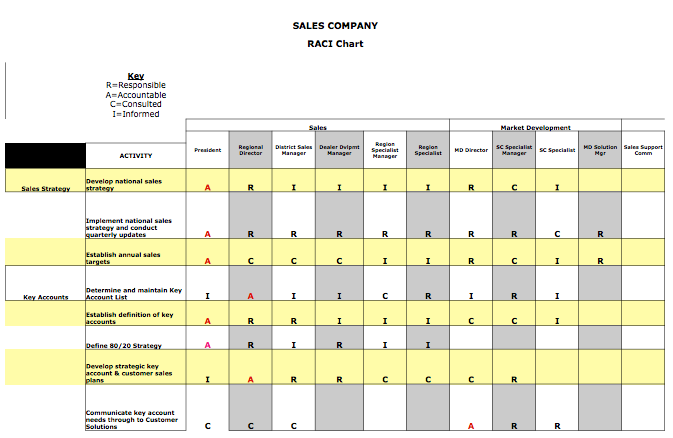“We will need to change some of our existing processes and ways of working with other departments when we implement new technology next month. I’m expecting complete chaos. How can I avoid confusion and bad feelings?”
#13: RACI
What is Roles and Responsibilities Charting/RACI?
RACI is a method to agree and document roles and responsibilities.
RACI stands for:
Where most other methods document only the person who is accountable for a decision or activity, RACI also documents who will be involved in doing the work, who will be consulted before a decision is taken, and who will be informed after the decision is taken or action accomplished.

When to use RACI
- When working across departments, groups or organizations where roles and responsibilities are not clear, and therefore duplication occurs or nothing gets done
- When changing a process or way of working
- When you want to communicate the difference between how something was done in the past and how it will be done in the future
- When introducing a new way of working
- When decision making authority is unclear
- When tasks are performed or decisions made at the wrong level of the organization
- When managing the interfaces is difficult
- Where finger pointing occurs when things go wrong
- Where ambiguities exist
How to use RACI
- Define the scope of exercise, i.e. the start and end points of a process.
- Document the key activities in the process on an Excel spreadsheet or Word document.
- Determine those people or positions involved on the other axis of your spreadsheet or document.
- Hold a meeting with representatives of each stakeholder group to define the RACI.
- Review the purpose of the RACI. Explain what it stands for and how it will be used.
- Confirm the scope and key activities with the group.
- Agree who has the ‘A’ for each activity.
- Fill in the Rs, Cs, and Is for each activity.
- Review the RACI for overall accuracy.
- Agree the communication and implementation plan.
- Communicate the results to all stakeholders.
- Enforce the new roles through the use of new job descriptions, measures, targets, etc. as required.
- Review the RACI with key stakeholders on a periodic basis to look for opportunities for improvement.
In Summary:
RACI is an excellent tool to articulate roles and responsibilities between groups and individuals.
- Define the scope of exercise.
- Document the key activities.
- Determine those people or positions involved.
- Hold a meeting with representatives of each stakeholder group to define the RACI.
- Communicate the results to all stakeholders.
- Implement the new roles.
- Review the RACI with key stakeholders on a periodic basis.
_________________
NOTE:
If you would like to receive e-mail notification when I post additional techniques, please sign up through this link. http://eepurl.com/KILan You may unsubscribe at any time.
You will find my book Mission Critical Meetings: 81 Practical Facilitation Techniques on Amazon. Your feedback and reviews are most welcome.

One Response to Fifteen Techniques for Implementing Decisions: #13 Roles and Responsibility Charting/RACI